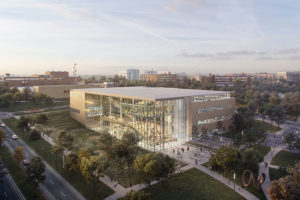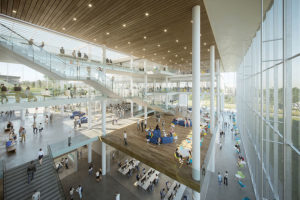
Articles New Kent State COBA building, in partnership with Signet, LLC, to transform KSU campus
“One of the premiere business schools in the region”
The Kent State Gateway Master Plan, started in 2018, is a decade long $1 billion dollar “transformative journey” to completely change the Kent State main campus.
The plan is divided into three phases, the first of which is a transformation of front campus that would include the construction of a new College of Business Administration.
“One of the key transformational projects is the building of a new COBA building on Main Street and [that] would really transform that whole area of campus,” said Mark Polatajko, vice president of finance and administration.
Vice President for Institutional Advancement Steve Sokany said the new building is the “priority project” for Deborah Spake, dean of the College of Business Administration.
The first issue Spake mentions about the current COBA building is the limiting factor of its size.
“This building is 100,000 square feet, roughly. The new one will be about 50 percent larger,” she said. “The reason for that is we outgrew this building a long time ago, and College of Business faculty teach in a number of buildings on campus. The purpose of having a bigger building is to bring those classes back under one roof.”
Having business students spread and trekking across campus was an issue that Spake returned to repeatedly. She put emphasis on centralizing the school.
“If you come to Kent State and take business courses it could be a couple years before you take a course in this building,” Spake said. “And so I think having a feeling that you are more connected to your major and your college is more likely in a new building.”
In addition to bringing classes together, the new building will also have space for advising offices, career services, a study abroad office and student organizations.
The new facility will not only physically expand the COBA, but also change and update the classrooms that make up the college.
The current building is made up almost entirely of tiered classrooms, meaning the seats are on raised platforms that rise away from the front.
Only two classrooms are flat floored, while the plans for the new COBA reverse that trend including only two tiered classes, while every other room is flat.
Spake said this is the “modern way of teaching business” and that it fosters a more collaborative and personal learning experience.
This transition will impact how professors interact with their students and teach their curriculum, so the current flat-floored rooms are being used to train for this new environment.
“The work that we are doing this year is to work with the faculty so that they begin to transition their teaching style from teaching in big lecture halls to teaching in these more active learning collaborative classrooms,” Spake said.
One of the tiered rooms is a 400-seat auditorium made for speaking events, rather than classes.
The theater is “in the round” which means the seats circle the middle of the rooms, and has a circular projection system.
All of these upgrades will make the College of Business Administration the largest and most modern college on campus, and the university is placing it at the forefront of the Master Plan redesign.
“We are placing this college at the front of the new signature entrance to the university,” said Eric Mansfield, executive director of university media relations. “So, for decades to come, the COBA will be the first college people see when they pull onto campus and that’s the commitment from the university. We want to be one of the premiere business schools in the region and in the nation, and we have to have a building that reflects that.”
The project is not just for prestige or aesthetics, Spake said she hopes it improves the quality of life of business students.
“I think it will increase the level of satisfaction that students get, so that they don’t feel like they are having to come and go from one building to another for all the activities that they do,” she said.
Project to be “shovel ready” by April

The project is being overseen by a group of companies led by Signet LLC, a private equity firm.
Signet and the architecture firm Perkins and Will won a 2018 design contest to earn the contract and have been working on plans ever since.
“We are just at the point where those construction documents are fully completed, in fact I just saw them this week,” Spake said.
Creating an entirely new building for the largest college on campus is no small feat, and it is projected to cost over $72 million and take at least two years.
“This is the most ambitious capital project we have ever embarked on,” said Sokany.
Despite the high price tag, President Todd Diacon has said he is committed to being “fiscally responsible” in the payment of the building and the Master Plan more generally.
This is reflected in the payment structure of the COBA building, which is based in a “public private partnership” with Signet.
“Public private partnership basically means that the university partners with a developer and a construction and financing group in order to design, build and then pay for the building of that project,” Polatajko said.
The university will then pay off its part of the partnership by renting the building over the course of 30 years, at the end of which the university will take full ownership.
With the construction documents done and the site fully surveyed by the end of March, the project will be considered “shovel ready” meaning only a step before construction begins is to finish financing.
Sovany is in charge of fundraising for the project, and Diacon has told him and Polatajko construction will begin when fundraising and pledges hit $20 million.
“We will have that shovel ready project because we’ve got the site identified and surveyed, we’ve got the construction documents, blueprints, everything available by the end of March,” Polatajko said. “The moment we hit that $20 million dollars, literally the president has said ‘the fence goes up and we start construction.’”
The fundraising is only at $11 million as of the beginning of February, but Sovany believes as the documents come in and the project takes shape donations will increase.
“We have been engaging more of our COB alumni with all the great things going on within the college and why a new building be the linchpin for taking the college to the next level,” Sovany said.
Sokany and Polatajko will continue to work together to organize the funding for the project that is supposed to transform the campus of Kent State.
Read the original article posted on Kentwired.com by Owen MacMillan, assigning editor. Contact him at omacmill@kent.edu.

